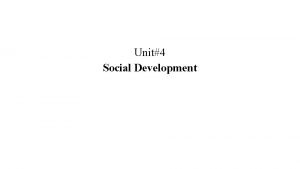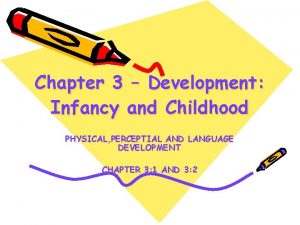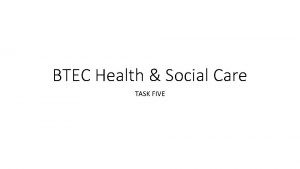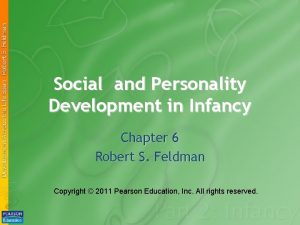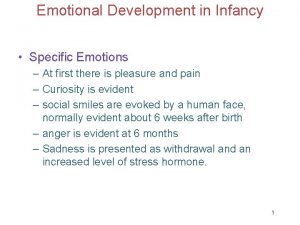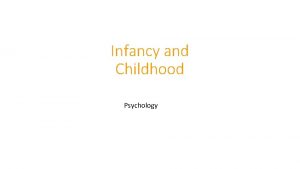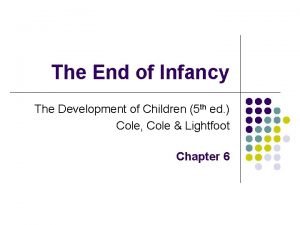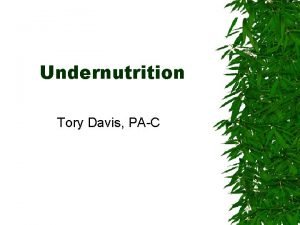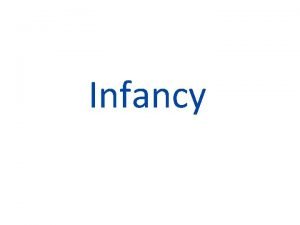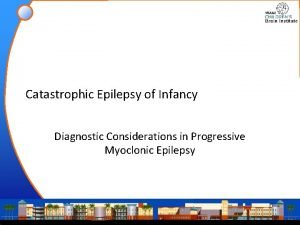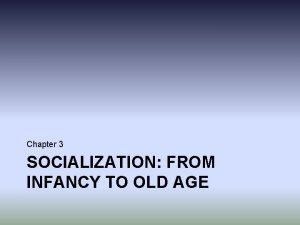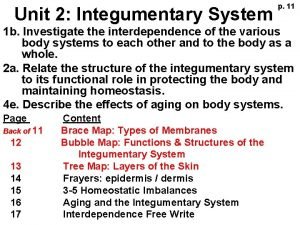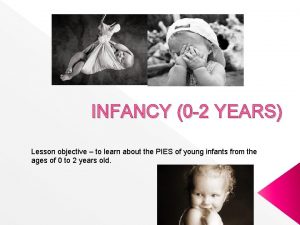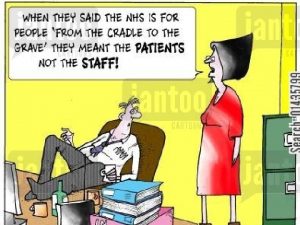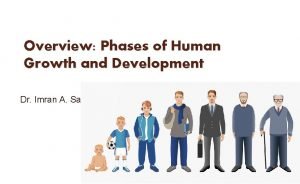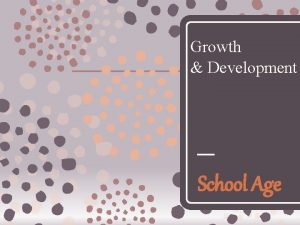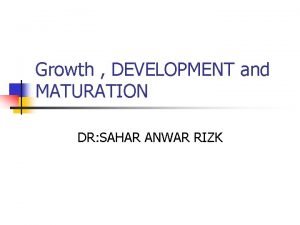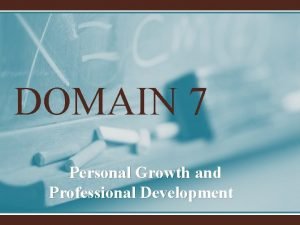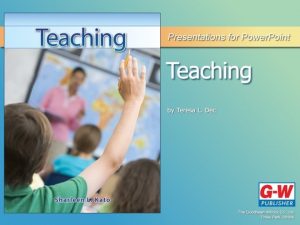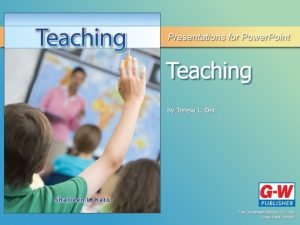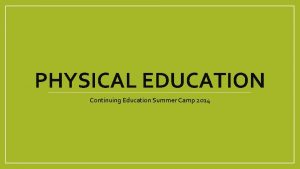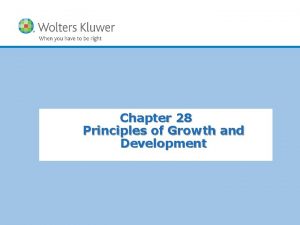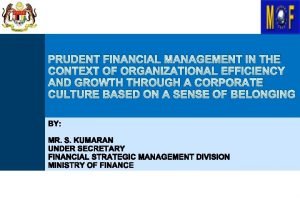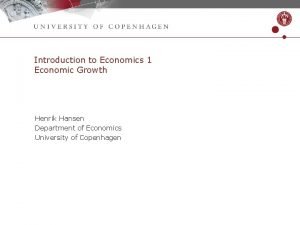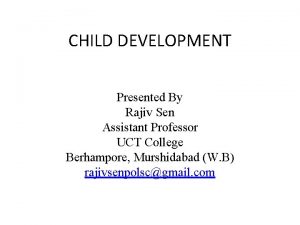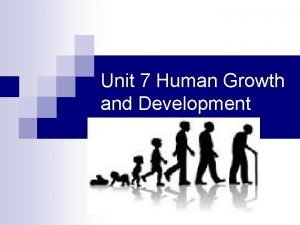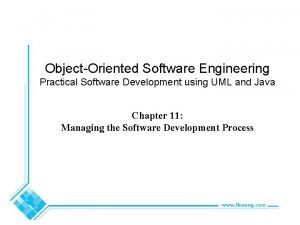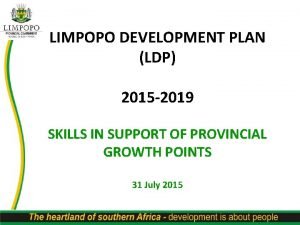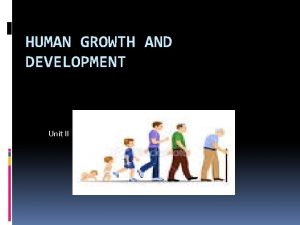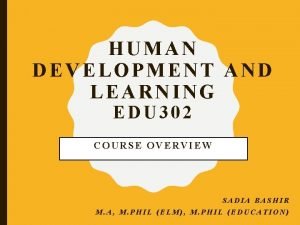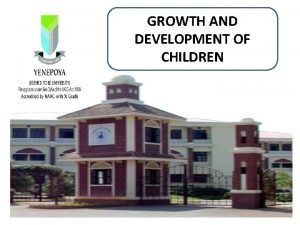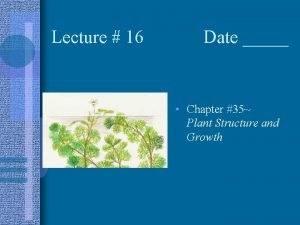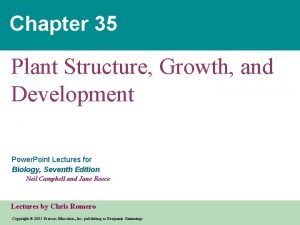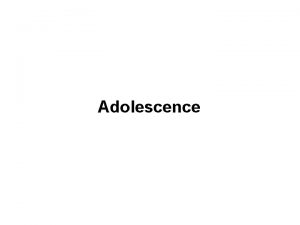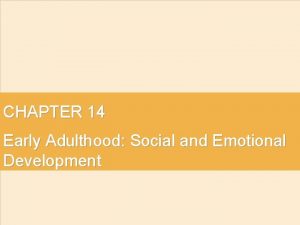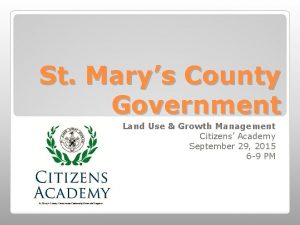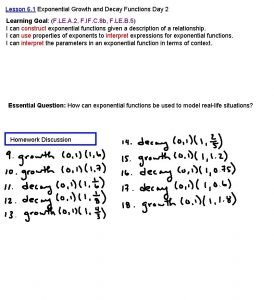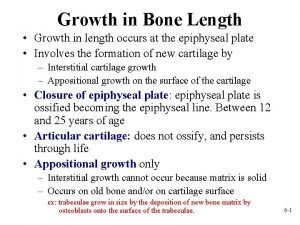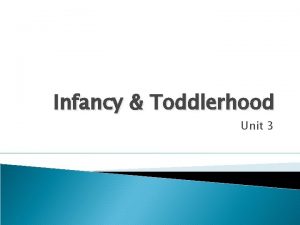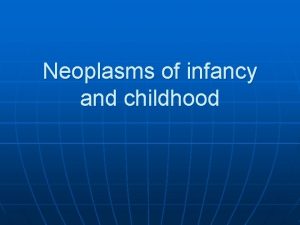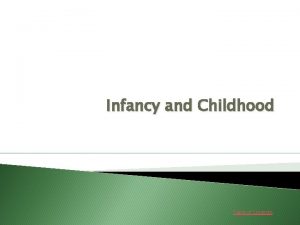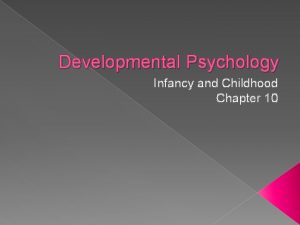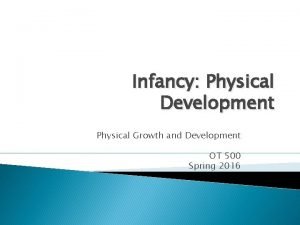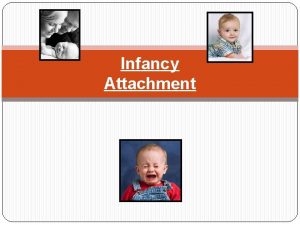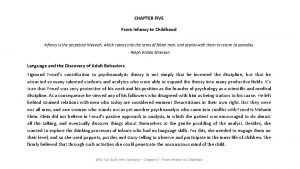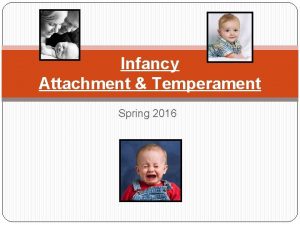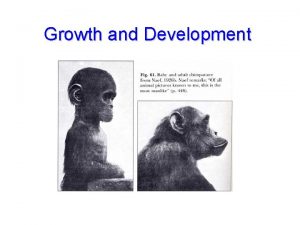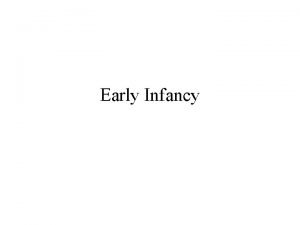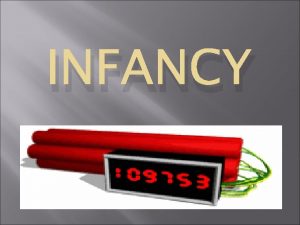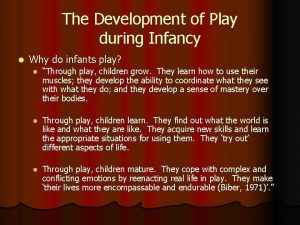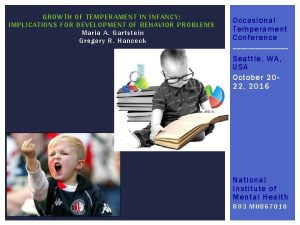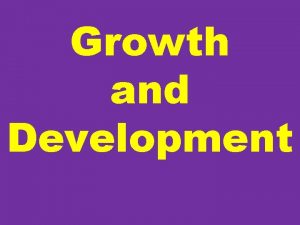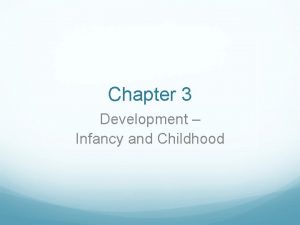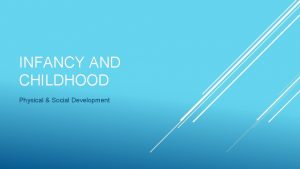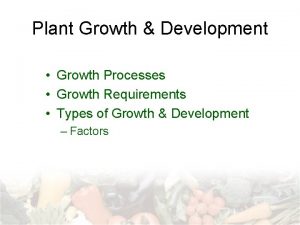Growth and development during Infancy n n n










































































- Slides: 74

Growth and development during Infancy n n n Physical growth Gross motor development Fine motor development Sensory development Vocalization Social and cognitive development

Age one month Physical growth: n Wt gain 120 -220 per week for first 6 months (in first 4 months, gains ¾ kg monthly). � Ht gain 2. 5 cm per month in first 6 month (25 cm in first year ) (Average length at birth is 50 cm, At one year about 75 cm and 100 cm at 4 years). n Primitive reflexes are present and strong.

n Temperature regulation is altered because of poorly sweating and shivering mechanism. n Normal respiratory rate from 32 -50 per minute, respiration is irregular and usually abdominal and obligatory nasal breather. n Normal blood pressure 82/46, pulse range from 110 -160/beat per minute.

Gross motor development : Assume flexed position with pelvis high when prone (Video) n Can turn head from side to side. n When supine position assume asymmetric tonic neck reflex (Video). tonic neck reflex n


Fine motor : n Hand predominantly closed; grasp reflex strong.

Sensory development : • Vision is poor, able to fixate on moving object in range of 45 degree when hold in distance of 25 cm. • follow light to midline • Neonate can be stimulated by held, rocked or watching a black and white mobile. • Hearing and touch are well developed, hearing may be altered because the ears are filled with amniotic fluid.

Vocalization : n Crying to express no pleasure n Make comfort sound during feeding.

Social and cognitive development : n Use of reflexes, watch parent face if talk directly to infant. n Brain growth depend on myelination.

Just a Note…… n n Myelination is the process of forming a myelin sheath around a nerve to allow nerve impulses to move more quickly. Myelin, which is made up of fatty lipids and proteins, accumulates around nerve cells, or neurons. Myelin plays an essential role in the health and function of nerve cells, the brain, and the nervous system

Age 2 months Physical growth : n Posterior fontanel closed. n Reflexes reach their peak specially sucking reflex which afford nutrition, survival and psychological pleasure.

Gross motor development: n When prone assume flexed position, turn head to side, can left head 45 degree of table. n When hold in sitting position, head is held up but bobs forward. n Hand frequently open. n Reflexive behavior is slowly replaced by voluntary movement.

Sensory development : n When supine, follow light from side to point beyond midline and show eye coordination to light and object. n Eye follow better both vertically and horizontally and focus well. n Turn head to side (towards sound ) when sound Turn head to side ( is made at level of ear.

Vocalization : n Crying become differentiated. n Vocalize to familiar voice.

Just a note…. Crying become differentiated The 6 types of cries n Babies tend to have different cries to express different needs or emotions. n n n 1. I'm hungry 2. I'm tired or uncomfortable 3. It’s noisy 4. I'm bored 5. I've got colic 6. I'm sick Decoding Your Baby’s 7 Types of Cries https: //www. whattoexpect. com/first-year/week-10/decoding-cries. aspx

Social and cognitive : n Demonstrate social smile to various stimuli. n Visually look to sound. n May squeal ﻳﺼﻴﺢ when stimulated by touching and talking.

Age 3 months Physical development: n The most of reflexes begin to disappear except for the protective reflexes such as (parachute, cough, swallow, and gag reflex). n Indicate preference for prone or supine position.

Gross motor: n Able to raise head and shoulder from prone position to 45 -90 degree angle from table. n Bear weight on forearm. n Able to hold head more erect when sitting but still bob forward. n Make crawling movement with legs, may get chest off surface.

Fine motor : n Actively hold rattle ﺧﺮﺧﺎﺷﺔ , pull blanket and Actively hold rattle clothes, and hand kept loosely open. n Has fairly good head control. n Discover hands - strike at objects while watching hands (Hand-Eye Coordination). n Hold object in hands and bring it to mouth.

Sensory motor : n Follow object peripherally "180 degree". Follow object peripherally n Locate sound by turning head and looking in same direction.

Vocalization: n Squeal at aloud to show pleasure, vocalize when smiling. n Babble ؛ ﺓ Babble ﺓ and coos ؛ ﺭ and coos ﻝ ؛ ﺭ .


Social and cognitive: n Can recognize familiar faces and feeding bottle. n Stop crying when mother enters room or when she crossed. n Enjoy playing during feeding. n Stay awake longer without crying. n Show pleasure from sucking, purposefully gets hands to mouth. n Is aware of strange situations.

Age 4 months Physical development: n Drooling begins. n Tonic neck and rooting reflexes have disappear.

Gross motor : n Has almost no head lag ﺗﺮﺍﺧﻲ when pulled to sitting position. n Balance head well in sitting position. n Rolls his body from back to side. n Sits with minimal support.

Fine motor development: n Inspect and play with hand. n Pulls clothes and blanket over face in play. n Grasp object with both hands and every thing goes into mouth. n Reached for offered object. n The infant explore own feet.

Sensory development : n Binocular vision ﺍﻟﻌﻴﻨﻴﺔ ﺛﻨﺎﺋﻲ fairly well Binocular vision established. n Begins eye-hand coordination. n Eye focus on small object. n Listen –turn head to familiar sound.

Just a note…. . n Binocular, comes from the Latin word bini, meaning ''two, '' and the Greek oculus, meaning ''eye. '' So, the term refers to two eyes focusing on one visual image.

Vocalization: n Laugh is loud. n Vocalization change according to mood. n Difference between pleasure and non pleasure sounds.

Socialization and cognitive : n Demand attention by fussing ﺗﺪﻟﻴﻞ . Demand attention by fussing n Become bored if left alone. n Enjoy social interaction with people. n Recognize and become more interested in mother. n Enjoy being propped ﻭﺩ in sitting Enjoy being propped position. n Actively interested in environment.

Age 5 months Physical development: n Birth weight doubles (150 – 220 g per week for first 6 Birth weight doubles months) and the length become 62 cm (2. 5 cm monthly). n Infant sleeps through the night with one or two naps a day.

Gross motor: n Can turn over from abdomen to back. n Can set for longer period if back well supported. n In supine position put feet in mouth. n When prone, the infant uses the arm to push the chest up and push the body toward the feet (try to crawl). n Infant sits only with support.

Fine motor : n Able to grasp an object voluntarily. n Can transfer an object from hand to another. n Play with toys. n Hold one cup for a second.

Sensory development: n Able to sustain visual inspection to an object. n Can localize and follow sound sources.

Vocalization : n Sequel, make vowel, cooing sound interpreted with consonant sound “ ah –hoo”.

Social and cognitive : n Smile at mirror image. n Put bottle or breast with both hands. n Discover part of the body.

Age 6 months Physical development: n Growth rate decline, wt gain 90 -150 gm weekly for the next 6 months. n Height gain 1. 25 cm per month for next 6 ms. n Head circumference gain 0. 5 cm monthly for the next 6 months. n Teething may begin with eruption of two lower central incisors.

Gross motor development : n When prone the infant can left chest and upper abdomen from table bearing weight on hands. n Sit in his high chair with back straight.

Fine motor development: n Rescue a dropped object and hold bottle. n Grasp and manipulate small objects.

Sensory development: n Prefer more complex visual stimuli. n Can localize sound made above the ear. n Well turn head to the side and look up or down.

Vocalization: n Begin to initiate sounds. n Babbling many syllables i. e. ma da hi.

Socialization and cognitive: n Recognize parents and begin to fear strangers. n Hold arms up to be picked up. n Response to own name. n Frequent mood swings from crying to laughing with little or no provocation.

Age 7 months Physical development : n Eruption of upper central incisors.

Gross motor : �Sit with support of both hands forward. �When putting in prone position , bear weight in one hand. �Can bear full weight on his feet. �Sit without support momentarily for short period of time.

Fine motor development: n Transfer object from one hand to another. n Transfer and put the object in mouth by one hand. n Can hold two cups for small period of time.

Sensory development : n Can fixate on very small object. n Has taste preference.

Vocalization: n Produce vowel sound and chained syllables Baba, Mama, dada, kaka. n Talk when another is talking to him.

Socialization and cognitive : n Increase fear from strangers and show sign of fearfulness when mother disappears. n Initiate simple act to noise. n Demonstrate dislike of food by keeping lip closed.

Age 8 months Physical development: n Begins to show regular pattern in bladder and bowel elimination. n Parachute reflex appears (or at 9 -month old).

Gross motor: n Sit steadily un-supported. n Adjust his /her posture to reach an object.

Fine motor development : n Rings bell purposely. n Secure an object by pulling on a string.

Sensory development : n Beginning awareness of depth and space.

Vocalization : n Listen selectively to familiar words. n Combines syllables such as mama, dada but still does not know the meaning of these words.

Socialization and cognitive : Has respond to the word NO. n Increase fear of strangers. n Increase anxiety when mother is not present. n

Age 9 months Physical development : n Eruption of upper lateral incisors.

Gross motor : n Creep ﻳﺰﺣﻒ on hands and knees. n Pull himself to stand holding of furniture.

Fine motor : n Pincer grasp by use of thumb and index. n The infant self feed crackers and a bottle.

Sensory development: n Localize sounds by turning head diagonally ﺩﺍﺋﺮﻱ , ﻗﻄﺮﻱ and directly toward sounds. n Increase depth perception.

Vocalization : n Responds to simple verbal commands/ comprehend no – no.

Socialization and cognitive: n Mother become more important to him. n Begin to fear of going bed and left alone. n Pull his arm in front of face to avoid washing. n The infant begins imitating the expression of others.

Age 10 months Gross motor n Infant become able to raise head n Can change from prone to sitting position n Stand well holding on furniture n Sits by falling down

Vocalization : § Begin to really speech , say mama dada with meaning § Comprehend bye

Socialization and cognitive n Inhibits behavior to verbal command No. n Imitate facial expression. n Respond to own name. n Wave hand with bye –bye. n Look and follow picture in book.

Age 11 months Physical development: n Eruption of lower lateral incisors may begin.

Gross motor: n Walk holding furniture or with hand supported. n When sitting: pivots to reach towards back to pick up object ( ﻟﻠﺨﻠﻒ )ﻳﺴﺘﺪﻳﺮ.

Fine motor : n explore object more thoroughly. n Put object after another into container (sequential play).

Vocalize : n Imitate definite speech sound.

Socialization and cognitive: n Experience joy and satisfaction when tasks mastered. n Learns to roll the ball back and forth when requested. n Shake head for no.

Age 12 months Physical development: n Birth weight tripled and height increased by 50% (in 6 months wt doubles). n Head circumference increase 2. 6 cm from 1224 months (0. 5 cm monthly from 6 -12 months). n Head and chest circumference about 47 cm n Has total 6 -8 teeth. n Babinski reflex disappear.

Gross motor : n Walk with support of one hand. n May attempt to stand alone for moment. n May attempted first step alone. n Can sit down from standing position without help.

Fine motor development: n Can release cup in cup. n Attempt to build tower of two block. n Can turn pages of book but many at the same time. Sensory development: n Can follow rapid moving object.

Language development: n Say 3 -5 words beside mama and Baba. n Comprehend meaning of several words. n Recognize object by name. n Imitate animal sounds. n Understand simple verbal command as : give me , show me.

Socialization and cognitive: n Anger and fear. n May give hug ﺇﺣﺘﻀﺎﻥ , ﻋﻨﺎﻕ or kiss when requested. May give hug n Enjoy familiar surrounding and explore away from parent. n Show emotion such as jealousy. END

For more infos n http: //www. parentingcounts. org/ n n n n Home Developmental Timeline Marketplace Professionals Research Newsletter About Us
 Slidetodoc.com
Slidetodoc.com Social development in infancy
Social development in infancy Ap psych schema
Ap psych schema Internally programmed growth of a child
Internally programmed growth of a child Intellectual meaning health and social care
Intellectual meaning health and social care Rovee-collier
Rovee-collier Module 47 infancy and childhood cognitive development
Module 47 infancy and childhood cognitive development Chapter 5 cognitive development in infancy and toddlerhood
Chapter 5 cognitive development in infancy and toddlerhood Socioemotional development in infancy
Socioemotional development in infancy Chapter 7 human growth and development
Chapter 7 human growth and development Stages of developmetn
Stages of developmetn Personality development in infancy
Personality development in infancy Personality development in infants
Personality development in infants Emotional development in infancy
Emotional development in infancy Infancy and childhood psychology
Infancy and childhood psychology Psychology chapter 10 infancy and childhood
Psychology chapter 10 infancy and childhood Chapter 10 infancy and childhood
Chapter 10 infancy and childhood Psychology chapter 10 infancy and childhood
Psychology chapter 10 infancy and childhood Lesson quiz 3-2 infancy and childhood
Lesson quiz 3-2 infancy and childhood Plant growth definition
Plant growth definition Primary growth and secondary growth in plants
Primary growth and secondary growth in plants Primary growth and secondary growth in plants
Primary growth and secondary growth in plants Chapter 35 plant structure growth and development
Chapter 35 plant structure growth and development Infancy period
Infancy period Middle childhood age
Middle childhood age Infancy
Infancy Infancy physical changes
Infancy physical changes Catastrophic epilepsy infancy
Catastrophic epilepsy infancy Socialization from infancy to old age
Socialization from infancy to old age Infancy childhood adolescence adulthood old age
Infancy childhood adolescence adulthood old age Pies in infancy
Pies in infancy Problems of infancy
Problems of infancy Infancy
Infancy Messianic prophecies fulfilled in the infancy narratives
Messianic prophecies fulfilled in the infancy narratives Carothers equation
Carothers equation Geometric growth vs exponential growth
Geometric growth vs exponential growth Neoclassical growth theory vs. endogenous growth theory
Neoclassical growth theory vs. endogenous growth theory Difference between organic and inorganic growth
Difference between organic and inorganic growth Social changes in adulthood
Social changes in adulthood Growth and development principles
Growth and development principles Stages of human growth and development pictures
Stages of human growth and development pictures Social development in middle adulthood
Social development in middle adulthood Pretest growth development and sexuality
Pretest growth development and sexuality Growth development and maturation
Growth development and maturation Growth and development conclusion
Growth and development conclusion Reflection about 7 domains of ppst
Reflection about 7 domains of ppst Growth and development pictures
Growth and development pictures Middle childhood growth and development
Middle childhood growth and development Distinguish between growth and development
Distinguish between growth and development Growth and development in physical education
Growth and development in physical education Rice plant stages
Rice plant stages Principles of growth and development
Principles of growth and development Prudent practices for organization growth and development
Prudent practices for organization growth and development Plant biology ppt
Plant biology ppt Economic growth and development
Economic growth and development Growth and development
Growth and development Social development in late adulthood
Social development in late adulthood Principles of human development
Principles of human development Limpopo provincial growth and development strategy
Limpopo provincial growth and development strategy Four main types of growth and development
Four main types of growth and development Difference between growth and development
Difference between growth and development Principle of growth and development
Principle of growth and development Chapter 35 plant structure growth and development
Chapter 35 plant structure growth and development Xylem und phloem
Xylem und phloem Economic growth vs economic development
Economic growth vs economic development Physical development during early adulthood
Physical development during early adulthood Physical development during adolescence
Physical development during adolescence Social development early adulthood
Social development early adulthood The history of community development
The history of community development Development that ended much development crossword
Development that ended much development crossword Pattern development
Pattern development St mary's county land use and growth management
St mary's county land use and growth management Interest rates and economic growth
Interest rates and economic growth Growth and decay formula
Growth and decay formula Epiphyseal plate
Epiphyseal plate

